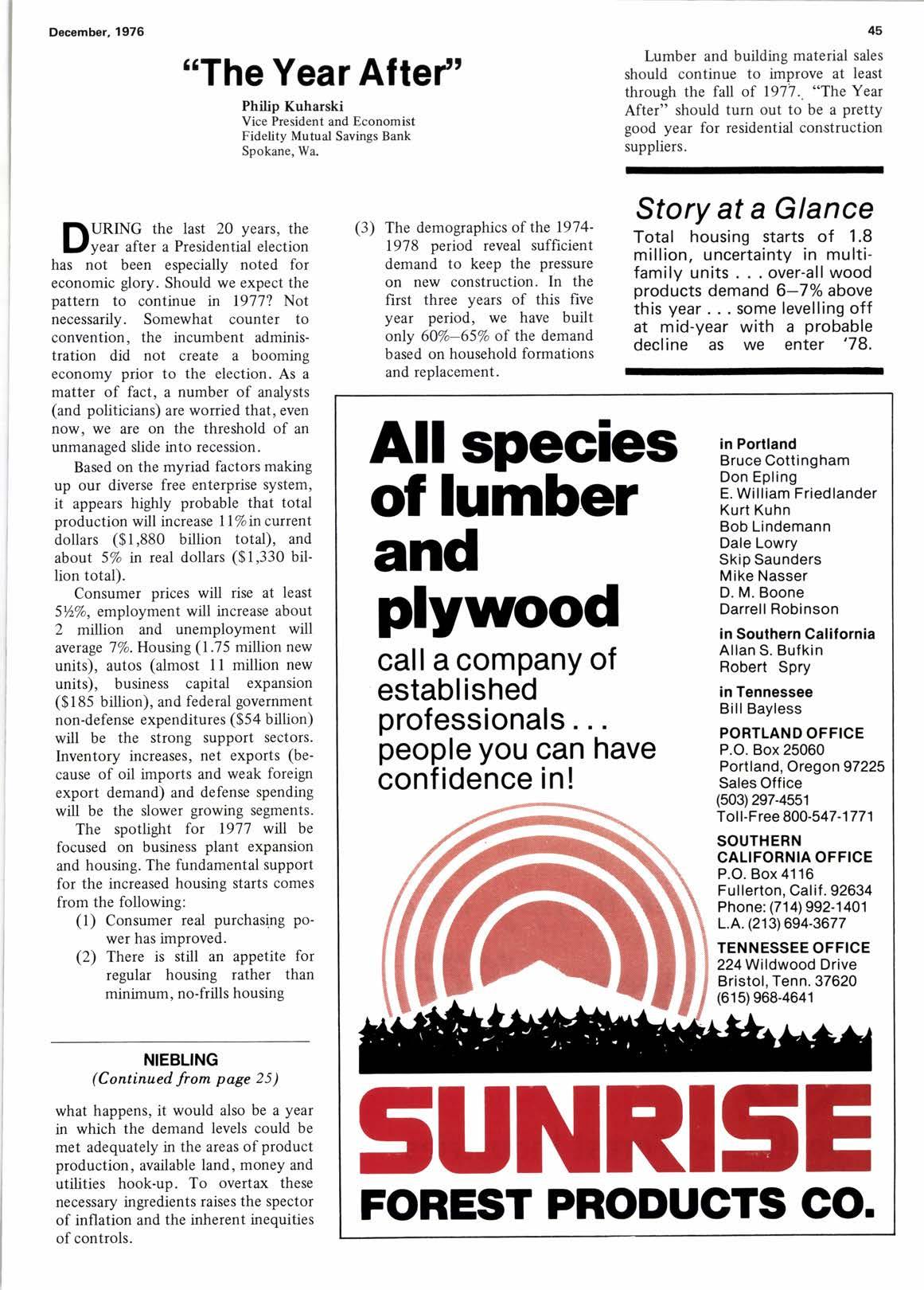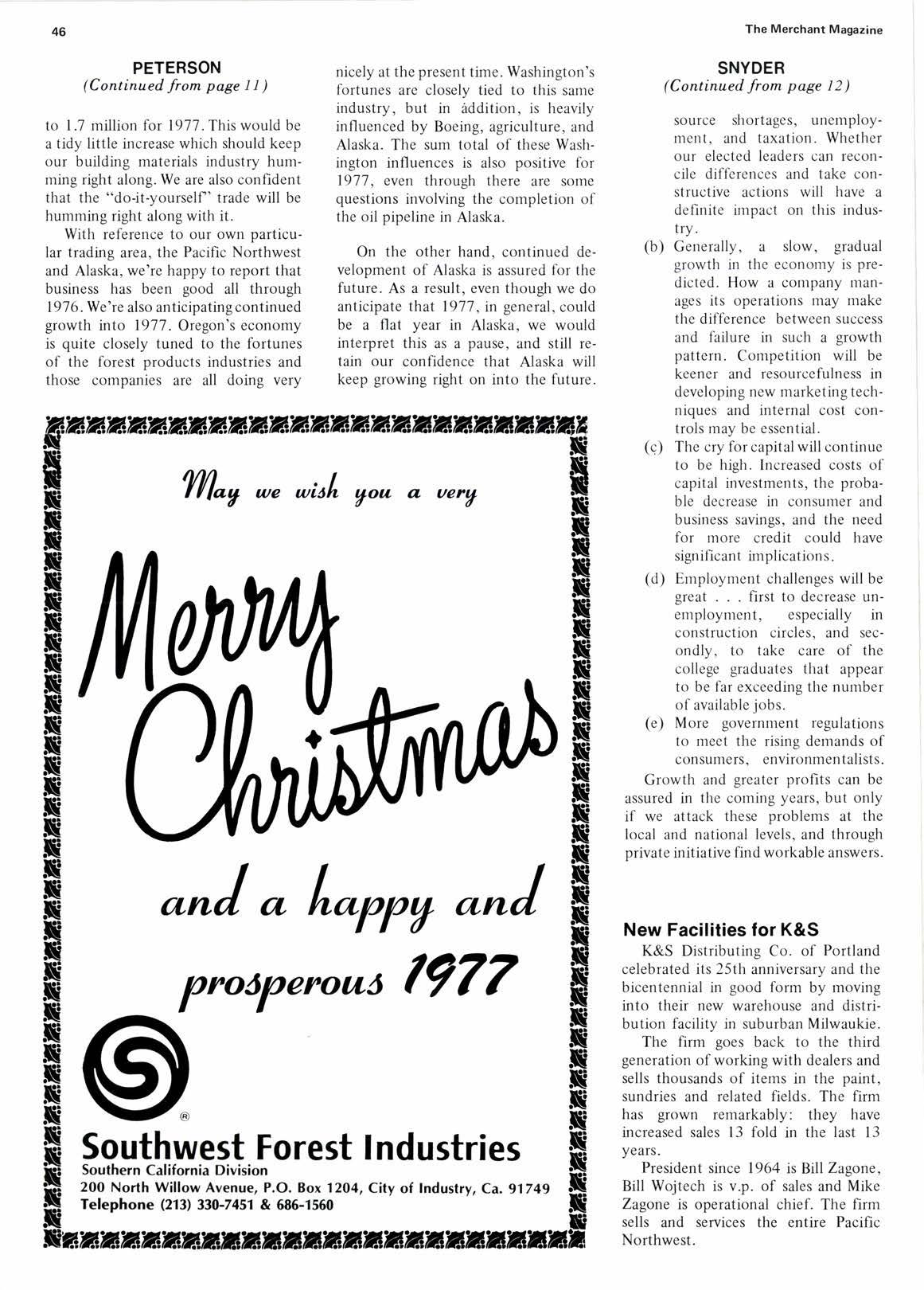
3 minute read
"The Year Afte/'
Philip Kuharski Vice President and Economist Fidelity Mutual Savings Bank Spokane, Wa-
I\URING the last 20 years, the Vyeat after a Presidential election has not been especially noted for economic glory. Should we expect the pattern to continue in 1977? Not necessarily. Somewhat counter to convention, the incumbent administration did not create a booming economy prior to the election. As a matter of fact, a number of analysts (and politicians) are worried that, even now, we are on the threshold of an unmanaged slide into recession.
Based on the myriad factors making up our diverse free enterprise system, it appears higtrly probable that total production will increase I l% rn current dollars ($1,880 billion total), and about 5% in real dollars ($1,330 bil' lion total).
Consumer prices will rise at least SlLVo, employment will increase about 2 million and unemployment will average 7 %. Housng (1.75 million new units), autos (almost I I million new units), business capital expansion ($185 billion), and federal government non-defense expenditures ($54 billion) will be the strong support sectors. Inventory increases, net exports (because of oil imports and weak foreign export demand) and defense spending will be the slower growing segments.
The spotlight for 1977 wrll be focused on business plant expansion and housing. The fundamental support for the increased housing starts comes from the following:
(l) Consumer real purchasing power has improved.
(2) There is still an appetite for regular housing rather than minimum, no-frills housing
Niebling
(Continued, from page 25) what happens, it would also be a year in which the demand levels could be met adequately in the areas of product production, available land, money and utilities hook-up. To overtax these necessary ingredients raises the spector of inflation and the inherent inequities of controls.
(3) The demographics of the 19741978 period reveal sufficient demand to keep the pressure on new construction. In the first three years of this five year period, we have built only 6O%-65% of the demand based on household formations and replacement.
Lumber and building material sales should continue to improve at least through the fall of 1977.. "The Year After" should turn out to be a pretty good year for residential construction suppliers.
Story at a Glance
Total housing starts of 1.8 million, uncertainty in multifamily units over-all wood products demand 6-7% above this year . some levelling off at mid-year with a probable decline as we enter '78.
in Portland
Bruce Cottingham
Don Epling
E. William Friedlander
Kurt Kuhn
Bob Lindemann
Dale Lowry
Skip Saunders
Mike Nasser
D. M. Boone
Darrell Robinson in Southern California
Allan S. Bufkin
Robert Spry in Tennessee
BillBayless
PORTLAND OFFICE P.O. Box 25060 Portland, Oregon 97225
Sales Office (503) 297-4551
Tol l-Free 800-547 -177'l
PETERSON (Continued from page I 1 ) to 1.7 million for 1971. This would be a tidy little increase which should keep our building materials industry humming right along. We are also confident that the "do-it-yourself' trade will be humming right along with it.
With reference to our own particular trading area, the Pacific Northwest and Alaska, we're happy to report that business has been good all through 197 6.'tN e' re also anticipating continued growth into 1977. Oregon's economy is quite closely tuned to the fortunes of the forest products industries and those companies are all doing very nicely at the present time. Washington's fortunes are closely tied to this same industry, but in iddition, is heavily influenced by Boeing, agriculture, and Alaska. The sum total of these Washington influences is also positive for 1977 , even through there are some questions involving the completion of the oil pipeline in Alaska.

On the other hand, continued development of Alaska is assured for the future. As a result, even though we do anticipate that 1977, in general, could be a flat year in Alaska, we would interpret this as a pause, and still retain our confidence that Alaska will keep growing right on into the future.
SNYDER (Continued from page 12) source shortages, unemployment, and taxation. Whether our elected leaders can reconcile differences and take constructive actions will have a definite impact on this industry.
(b) Generally, a slow, gradual growth in the economy is predicted. How a company manages its operations may make the difference between success and failure in such a growth pattern. Competition will be keener and resourcefulness in developing new marketing techniques and internal cost controls mav be essential.
(q) The cry for capital will continue to be high. Increased costs of capital investments, the probable decrease in consumer and business savings, and the need for more credit could have significant implications.
(d) Employment challenges will be great . . first to decrease unemployment, especially in construction circles, and secondly, to take care of the college graduates that appear to be far exceeding the number of available jobs.
(e) More government regulations to meet the rising demands of consumers, environmentalists.
Growth and greater profits can be assured in the coming years, but only if we attack these problems at the local and national levels, and through private initiative find workable answers.
New Facilities for K&S
K&S Distributing Co. of Portland celebrated its 25th anniversary and the bicentennial in good form by moving into their new warehouse and distribution facility in suburban Milwaukie. The firm goes back to the third generation of working with dealers and sells thousands of items in the paint, sundries and related fields. The firm has grown remarkably: they have increased sales 13 fold in the last 13 years.
President since 1964 is Bill Zagone, Bill Wojtech is v.p. of sales and Mike Zagone is operational chief. The firm sells and services the entire Pacific Northwest.










